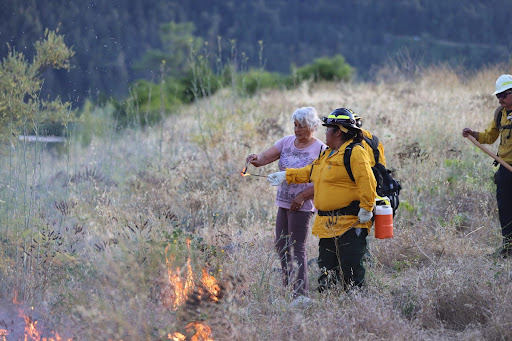Overview
Pa’asik’tavaansas Kuniktáamvunatih (The Women are Carrying Fire)

Author:
Aatishipaan Tripp (Yurok/Karuk), Co-Author
Maggie Peters (Yurok/Karuk), Humboldt County Office of Education Co-Author
Karuk Women’s Fire Training and Exchange Program
Maymi Donahue (Karuk), Karuk Language Consultant
Grades: 9th-12th grade
Suggested Amount of Time: 3 class periods of a minimum of 55 minutes. Recommend increasing the last session to two sessions to support thorough review of resources and collaboration in final responses.
Curriculum Themes
- History
- Cultural Strengths
- Law/Government
- Relationship to Place
- Cross Curricular Integration
Learning Goals
Understand the history of fire use for Karuk women and how fire is essential for cultural sustainability.
Identify the unique practices and purpose of the Karuk Women’s Fire Training and Exchange Program.
Understand the importance of integrating Karuk Language to environmental practice.
Differentiate cultural fire from prescribed burning (áhish / áhishrih: To set/Light a fire)
Become familiarized with the certifications earned through participation in the KWTREX
Appreciate the Karuk Tribe’s role in revitalization of cultural fire practices.
Unit Overview
The unit titled Pa’asik’tavaansas Kuniktáamvunatih ("The Women are Carrying Fire") exposes high school students to the Karuk Tribe's cultural and ecological practices, emphasizing the integral role of fire in their traditions and environmental stewardship. Students will learn that Karuk people have utilized controlled, low-intensity burns for millennia to manage landscapes, enhance biodiversity, and maintain cultural practices. These methods, deeply embedded in the Karuk language and worldview, were disrupted by over a century of federal fire suppression policies. The Karuk Women's Fire Training and Exchange (KWTREX) program is a contemporary initiative aimed at revitalizing these traditions, empowering Indigenous women and Two-Spirit individuals to lead cultural burns and reclaim their ancestral fire practices.
In these lessons, students will experience the dedication and responsibility to tenure land for cultural preservation of traditions like food sovereignty and the arts like basketry. Through a film produced by the KWTREX program, students will hear firsthand accounts from Indigenous women and Two-Spirit participants, sharing their experiences of healing and empowerment through cultural fire practices. The lesson will also introduce the concept of Traditional Ecological Knowledge (TEK) and its transmission through language, highlighting how the Karuk language encodes ecological wisdom related to fire management. Students will examine the differences between cultural fire and prescribed burning. By engaging with resources such as the Karuk Tribe's cultural fire storymap, students will research and reflect on the significance of cultural fire practices in adapting to climate change and restoring ecological balance.
The overarching goal of this lesson is to foster an appreciation for Indigenous knowledge systems and their relevance in contemporary environmental challenges. Students will gain insight into the Karuk Tribe's efforts to revitalize cultural fire practices and the importance of language in preserving and transmitting ecological knowledge. Through these language integrated lessons, students will recognize the resilience and agency of Indigenous communities and their leadership in providing the necessary training for Karuk women in spaces traditionally occupied by men.
Teacher Background
The Karuk Tribe has a historic, profound relationship with fire, having cultural, ecological, and linguistic significance - fire truly is a cultural resource- just as important to cultural survival as salmon, acorns, and basket material. Since time immemorial, the Karuk people have utilized controlled, low-intensity burns to manage landscapes, enhance biodiversity, and maintain cultural practices. These methods, deeply embedded in the Karuk epistemology, were disrupted by over a century of federal fire suppression policies. The devastating impacts of colonialism may not be a consideration for most Californians, but for Native people, it has at caused genocide, cutural erasure, assilimation, and multigeneral trauma.
To effectively teach these lessons, educators must approach the material with cultural humility and an openness to Indigenous perspectives. Cultural humility involves an ongoing process of self-reflection and learning, recognizing and challenging power imbalances, and building respectful partnerships with Indigenous communities. This approach encourages educators to view students as experts on their own identities and experiences, fostering an environment of mutual respect and understanding.
Incorporating Indigenous perspectives into the classroom requires intentional strategies. Educators should integrate Indigenous knowledge and practices into lessons, ensuring that these perspectives are represented accurately and respectfully. By collaborating with Indigenous community members, utilizing resources created by Indigenous peoples, and providing opportunities for students to engage directly with Indigenous voices and experiences, students will grow to see Tribes as partners in the future.
Creating inclusive, collaborative learning environments is a great strategy. By creating spaces where all students feel valued and heard, they feel more confident to share and participate in open dialogue and critical thinking. This involves being mindful of the diverse cultural backgrounds of students and ensuring that classroom materials and discussions reflect this diversity.

